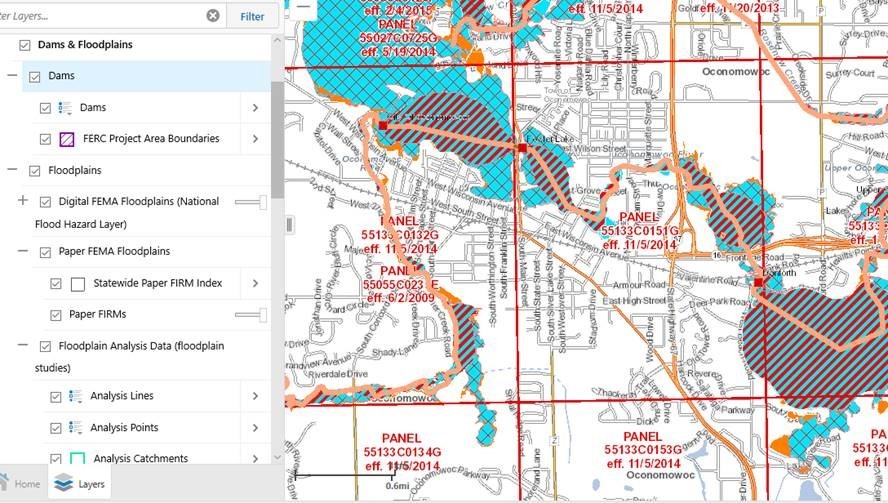
The DNR launched an enhancement to the Surface Water Data Viewer (SWDV) dam and floodplain layer theme. The layer groupings have been reorganized to make the structure more logical and intuitive.
For an easy way to view the dam and floodplain mapping and modeling information, follow these steps:
- Use the link above in the browser of your choosing. It will bring you to a map of the entire state. Use the zoom tools in the top toolbar to zoom to your location of interest.
- Then, click on the “show layers” icon in the top toolbar. There is a sidebar that appears on the left, listing available layers.
- At the top of this sidebar, there is a dropdown menu. Pull it down and choose a layer theme of “dam and floodplain information”. Note in the sidebar that there is a grouping titled “Dams & Floodplains” that appears with a checkmark next to it, with multiple subgroupings appearing below it. Selecting this grouping turns on several useful data layers related to dams and floodplains; an explanation of the layers that automatically appear is given in the next part of this article.
- Many more layers are available that do not immediately turn on. Boxes with a checkmark next to them in the groups or individual layers are visible in the map window. Toggle on the checkmark box to turn them on or off. Additionally, layer groups have a “+” or “-“ sign in front of them. Click on the “+” to expand a group; click on a “-“ to collapse a group.
“DAMS” SUBGROUP
The subgroup titled “Dams” contains two layers that turn on: “Dams” and “Federal Energy Regulatory Commission or FERC Project Boundaries”. The “Dams” layer shows the locations of dams on record with the department, represented by points. In areas where hydropower dams, regulated by FERC exist, the “FERC Project Boundaries” layer shows lands where the FERC licensing requirements for such dams are applicable.
“FLOODPLAINS” SUBGROUP
The subgroup title “Floodplains” contains four sub-subgroupings, which are explained below.
The sub-subgroup titled “Digital FEMA Floodplains (National Flood Hazard Layer)” contains flood map information that is “streamed” from the Federal Emergency Management Agency (FEMA) database. The layers that automatically turn on when the theme is selected are the “Flood Insurance Rate Maps, or FIRM Panels”, “Flood Hazard Zones” and “Cross Sections” layers.
The FIRM Panels are rectangles that represent outlines of individual FEMA maps. The “Flood Hazard Zones” correspond to risk zones; the “1% Annual Chance Flood Hazard” and “Floodway” areas are what are collectively more commonly known as 100-year floodplains and are the extents of areas regulated by local floodplain ordinances. The “Cross Sections” correspond with locations where specific 100-year flood elevations are computed by hydraulic model simulations and used for floodplain ordinance administration.
The sub-subgroup titled “Paper FEMA Floodplains” contains scanned copies of paper maps showing regulatory floodplain boundaries, flood elevations, cross-sections, etc., overlaid in a GIS environment. This layer only applies to a few counties in the state where FEMA has not yet converted to digital data.
The sub-subgroup titled “Floodplain Analysis Data” shows locations where hydrologic and/or hydraulic model data has been developed for determining regulatory flood extents. Their locations will be represented either by highlighted stream lines (where models were done for stretches of stream) or points (where only a limited study was done for, say, a bridge or individual property).
The color of the highlighting represents study types. The DNR has digital copies of model data for many of these streams; contact your regional Water Management Engineer for details on how to retrieve models.
The sub-subgroup titled “Digital State Floodplains” contains flood study information that has been developed for other zoning purposes; while FEMA does not adopt the data, it typically has zoning and/or risk implications for the mapped area.
The “Floodplains” and “Cross Section” layers in this group are the results of non-FEMA flood studies or dam failure analyses (DFAs). The “Flood Storage Districts” layer (note: this layer is not automatically turned on by selecting the theme) shows areas where ponded water volumes have been accounted for in determining flood discharges.
One final note – while the SWDV contains a lot of useful information, these are not official regulatory maps. The viewer is limited to the data that is available digitally and is not comprehensive. Official floodplain data and information is maintained and governed by local (city, village, or county) ordinances and zoning.
If you have questions about whether floodplain regulations govern your property or a potential project, first contact your local zoning administrator and if additional assistance is needed, contact the DNR water management engineer assigned to your county.
|